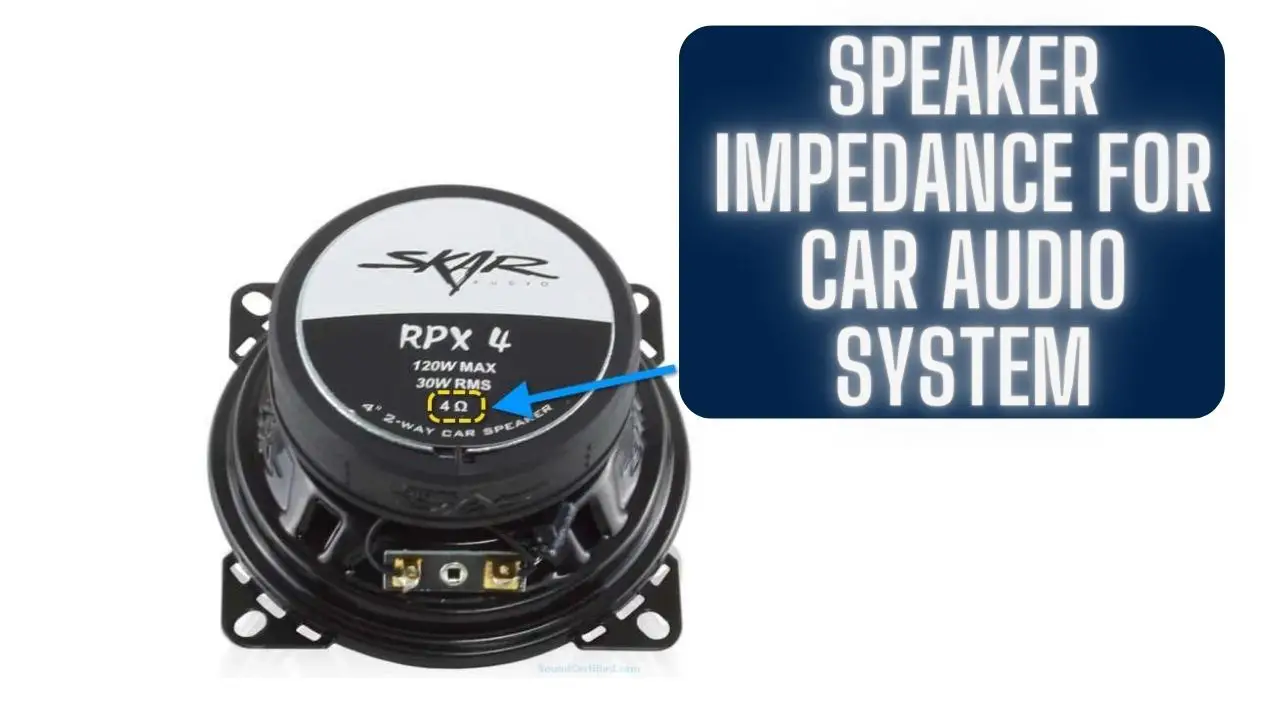Speaker Impedance for Car Audio Systems: Choosing the Right Match
Introduction
Speaker impedance is a crucial factor to consider in audio systems, including car audio setups. It refers to the resistance that an electrical circuit, such as a speaker, presents to the flow of alternating current (AC) from an amplifier. Understanding speaker impedance is essential for ensuring compatibility between speakers and amplifiers, optimizing performance, and preventing damage to audio components.
In car audio systems, speakers typically have impedance ratings measured in ohms (Ω). Common impedance ratings for car speakers include 2 ohms, 4 ohms, and 8 ohms, although other values are also available. The impedance rating indicates how much electrical resistance the speaker presents to the amplifier’s output.
Different impedance ratings affect how much electrical current flows through the speaker when driven by the amplifier. Higher impedance speakers (e.g., 8 ohms) allow less current to flow, while lower impedance speakers (e.g., 2 ohms) allow more current to flow.
Understanding Speaker Impedance
Speaker impedance is a measure of the opposition to the flow of electrical current presented by a speaker to the amplifier. It is measured in ohms (Ω) and represents the total resistance of the speaker’s voice coil to the flow of alternating current (AC) from the amplifier.
Here are some key points to understand about speaker impedance:
- Resistance vs. Impedance: While resistance (measured in ohms) refers to the opposition to the flow of direct current (DC), impedance takes into account both resistance and reactance (which is the opposition to the flow of AC due to inductance or capacitance). In speakers, impedance primarily consists of resistance from the voice coil and reactance from the speaker’s inductance.
- Nominal Impedance: Speakers are typically labeled with a nominal impedance rating, such as 4 ohms, 8 ohms, or 16 ohms. This rating represents the average impedance value over the speaker’s frequency range and serves as a reference point for amplifier matching.
- Dynamic Impedance: Speaker impedance varies with frequency, and different speakers may have complex impedance curves. The nominal impedance rating provides a general guideline, but actual impedance may deviate from this value at different frequencies.
- Amplifier Compatibility: Amplifiers are designed to work with specific impedance loads. It’s important to match the impedance of the speakers to the amplifier’s minimum and maximum impedance ratings to ensure proper operation and prevent damage to both the amplifier and speakers.
- Effects on Power Output: Lower impedance speakers draw more current from the amplifier and can result in higher power output. However, driving a lower impedance load may push the amplifier beyond its limits and lead to overheating or distortion. Conversely, higher impedance speakers draw less current and may result in lower power output.
- Wiring Configurations: In multi-speaker setups, different wiring configurations, such as series or parallel connections, can affect the total impedance presented to the amplifier. Series connections increase impedance, while parallel connections decrease impedance. Understanding these wiring options allows for flexibility in system design and impedance matching.
- Sound Quality: Proper impedance matching between the amplifier and speakers ensures efficient power transfer and optimal performance. Mismatched impedance can result in reduced power transfer, frequency response anomalies, and distortion, affecting overall sound quality.
In summary, speaker impedance is a crucial factor in audio system design and operation. Understanding speaker impedance and its implications allows for proper amplifier matching, optimal power delivery, and high-quality sound reproduction in audio systems, including car audio setups.
Impedance Matching in Car Audio Systems
Impedance matching is a critical consideration in car audio systems to ensure compatibility between speakers and amplifiers, optimize power transfer, and achieve optimal sound quality. Proper impedance matching helps prevent issues such as amplifier overheating, distortion, and damage to audio components. Here’s how impedance matching works in car audio systems:
- Amplifier Impedance Rating: Amplifiers in car audio systems are designed to operate within specific impedance ranges. The amplifier’s user manual or specifications sheet typically provides information on the recommended impedance range for speaker connections.
- Speaker Impedance Rating: Car speakers are labeled with a nominal impedance rating, typically 2 ohms, 4 ohms, or 8 ohms. It’s essential to match the impedance of the speakers to the amplifier’s impedance rating for optimal performance.
- Matching Speaker and Amplifier Impedance: Matching the impedance of the speakers to the amplifier’s recommended impedance range ensures efficient power transfer and prevents overloading or underloading the amplifier. For example, if the amplifier is rated for a minimum impedance of 4 ohms, using speakers with a nominal impedance of 4 ohms is ideal.
- Impedance Mismatching: Mismatched impedance between speakers and amplifiers can lead to several issues. If the speaker impedance is too low for the amplifier, it may draw excessive current, leading to overheating, distortion, or even amplifier damage. Conversely, if the speaker impedance is too high, it may not draw enough current, resulting in reduced power output and degraded sound quality.
- Wiring Configurations: In multi-speaker setups, the wiring configuration can affect the total impedance presented to the amplifier. Series and parallel wiring configurations can be used to adjust the overall impedance of the speaker system to match the amplifier’s impedance requirements.
- Amplifier Stability: Impedance matching is crucial for maintaining amplifier stability and preventing oscillations or instability, especially in high-power audio systems. Matching the impedance of the speakers to the amplifier’s recommended range helps ensure proper load conditions and reliable operation.
- Consulting Manufacturer Specifications: It’s essential to consult the specifications provided by the amplifier and speaker manufacturers to ensure proper impedance matching. This includes verifying the recommended impedance range for the amplifier and selecting speakers with compatible impedance ratings.
By ensuring proper impedance matching in car audio systems, enthusiasts can optimize power transfer, prevent amplifier damage, and achieve high-quality sound reproduction for an enhanced listening experience on the road.
Speaker Impedance Ratings
Speaker impedance ratings indicate the electrical resistance of the speaker’s voice coil and are measured in ohms (Ω). Understanding speaker impedance ratings is essential for selecting compatible speakers and amplifiers and ensuring optimal performance in car audio systems. Here are some key points about speaker impedance ratings:
- Nominal Impedance: The nominal impedance rating represents the average impedance value of the speaker over its frequency range. Common nominal impedance ratings for car speakers include 2 ohms, 4 ohms, and 8 ohms, although other values are also available.
- Minimum Impedance: Speakers may have a minimum impedance rating, which indicates the lowest impedance value the speaker presents to the amplifier. This rating is important for amplifier compatibility and ensures that the amplifier can handle the speaker’s electrical load without overheating or distortion.
- Variability with Frequency: Speaker impedance can vary with frequency, particularly in complex speaker designs such as multi-driver systems or speakers with crossover networks. While the nominal impedance provides a general guideline, the actual impedance may deviate from this value at different frequencies.
- Effect on Amplifier Output: The impedance rating of the speaker affects how much electrical current flows from the amplifier to the speaker. Lower impedance speakers (e.g., 2 ohms) draw more current and may result in higher power output from the amplifier, while higher impedance speakers (e.g., 8 ohms) draw less current and may result in lower power output.
- Amplifier Compatibility: It’s crucial to match the impedance of the speakers to the amplifier’s impedance rating to ensure proper operation and prevent damage to audio components. Amplifiers are designed to work within specific impedance ranges, and using speakers with impedance values outside of this range can lead to performance issues or amplifier failure.
- Wiring Configurations: In multi-speaker setups, different wiring configurations, such as series or parallel connections, can be used to adjust the total impedance presented to the amplifier. Series connections increase impedance, while parallel connections decrease impedance, allowing for flexibility in system design and impedance matching.
- Power Handling: Speaker impedance ratings also affect the power handling capability of the speaker. Lower impedance speakers may draw more power from the amplifier and can handle higher power levels, while higher impedance speakers may have lower power handling capabilities.
By understanding speaker impedance ratings and their implications, car audio enthusiasts can select speakers and amplifiers that are compatible with each other, ensuring optimal performance and sound quality in their audio systems.
Choosing the Right Speaker Impedance
Choosing the right speaker impedance is crucial for ensuring compatibility with your amplifier, optimizing power transfer, and achieving optimal sound quality in your car audio system. Here are some factors to consider when selecting the appropriate speaker impedance:
- Amplifier Compatibility: Refer to the specifications of your amplifier to determine its recommended impedance range. Amplifiers are designed to work within specific impedance ranges, and using speakers with impedance values outside of this range can lead to performance issues or amplifier damage. Choose speakers with impedance ratings that fall within the recommended range of your amplifier.
- Power Handling: Consider the power handling capabilities of the speakers and the amplifier. Lower impedance speakers may draw more power from the amplifier and can handle higher power levels, while higher impedance speakers may have lower power handling capabilities. Ensure that the speakers can handle the power output of the amplifier without exceeding their maximum power rating.
- Wiring Configurations: Understand the wiring options available for your speaker setup and how they affect impedance. In multi-speaker setups, different wiring configurations, such as series or parallel connections, can be used to adjust the total impedance presented to the amplifier. Series connections increase impedance, while parallel connections decrease impedance. Choose wiring configurations that allow you to achieve the desired impedance matching with your amplifier.
- Sound Quality: Consider the impact of speaker impedance on sound quality. While lower impedance speakers may offer higher power output from the amplifier, they may also be more demanding on the amplifier and result in increased distortion or reduced dynamic range. Higher impedance speakers may be more forgiving on the amplifier and offer better sound quality in some cases. Choose speakers with impedance ratings that balance power handling and sound quality based on your preferences.
- System Design Goals: Consider your overall system design goals and preferences when selecting speaker impedance. If you prioritize maximum power output and efficiency, you may opt for lower impedance speakers. If you prioritize sound quality and amplifier stability, you may opt for higher impedance speakers. Choose speakers with impedance ratings that align with your system design goals and preferences.
By considering these factors, you can choose the right speaker impedance for your car audio system, ensuring compatibility with your amplifier, optimizing power transfer, and achieving the desired sound quality for an enhanced listening experience on the road.
Wiring Configurations for Different Impedances
Wiring configurations for different speaker impedances are essential for adjusting the total impedance presented to the amplifier and ensuring compatibility with your audio system. Here are common wiring configurations used in car audio setups for different speaker impedances:
- Series Wiring:
- Two Speakers in Series: Connect the positive terminal of one speaker to the positive terminal of the amplifier. Connect the negative terminal of the same speaker to the positive terminal of the second speaker. Finally, connect the negative terminal of the second speaker to the negative terminal of the amplifier. This configuration increases the total impedance and is useful when using speakers with lower impedance ratings.
- Effect on Impedance: When two speakers of the same impedance are wired in series, the total impedance is the sum of the individual impedances. For example, if two 4-ohm speakers are wired in series, the total impedance will be 8 ohms.
- Parallel Wiring:
- Two Speakers in Parallel: Connect the positive terminals of both speakers to the positive terminal of the amplifier. Connect the negative terminals of both speakers to the negative terminal of the amplifier. This configuration decreases the total impedance and is useful when using speakers with higher impedance ratings.
- Effect on Impedance: When two speakers of the same impedance are wired in parallel, the total impedance is calculated using the formula: Total Impedance = (Impedance of one speaker) / (Number of speakers). For example, if two 8-ohm speakers are wired in parallel, the total impedance will be 4 ohms.
- Series-Parallel Wiring:
- Combination of Series and Parallel: This wiring configuration involves both series and parallel connections to achieve the desired total impedance. It allows for flexibility in adjusting the total impedance to match the amplifier’s impedance requirements.
- Example: For example, if you have four 4-ohm speakers and want to achieve a total impedance of 4 ohms, you can wire two pairs of speakers in series (resulting in 8-ohm pairs) and then wire the two pairs in parallel.
- Impedance Matching Transformers:
- External Transformers: In some cases, external impedance matching transformers may be used to adjust the impedance of the speakers to match the amplifier’s requirements. These transformers are placed between the amplifier and speakers and provide impedance matching capabilities.
When selecting wiring configurations for different speaker impedances, it’s essential to consider the amplifier’s impedance requirements, power handling capabilities, and the desired total impedance of the speaker setup. By understanding these wiring options, you can effectively adjust the total impedance presented to the amplifier and ensure optimal performance in your car audio system.
Effects of Speaker Impedance on Amplifier Performance
The speaker impedance has significant effects on the performance of the amplifier in a car audio system. Here are some key effects:
- Power Output: The impedance of the speaker affects the amount of electrical current drawn from the amplifier. Amplifiers are designed to work within specific impedance ranges, and they deliver different power levels depending on the impedance of the connected speakers. Lower impedance speakers (e.g., 2 ohms) draw more current from the amplifier and can produce higher power output compared to higher impedance speakers (e.g., 8 ohms), which draw less current and produce lower power output.
- Stability: Amplifiers are more stable when operating within their recommended impedance range. Mismatched impedance between the amplifier and speakers can cause instability, oscillations, and even damage to the amplifier. Using speakers with impedance values outside of the recommended range can lead to overheating, clipping, and distortion in the amplifier.
- Efficiency: Amplifiers operate more efficiently when matched with speakers of the correct impedance. When the amplifier and speakers are well-matched in impedance, power transfer is optimized, and energy wastage is minimized. Mismatched impedance can result in inefficient power transfer, leading to reduced amplifier efficiency and potentially higher power consumption.
- Frequency Response: The impedance curve of the speaker can affect the amplifier’s frequency response. Speakers with varying impedance characteristics may present different loads to the amplifier at different frequencies, leading to variations in frequency response. Amplifiers with stable performance across a wide range of impedance values can maintain consistent frequency response with different speakers.
- Distortion: Mismatched impedance between the amplifier and speakers can cause distortion in the audio signal. Amplifiers may struggle to deliver the required current to speakers with lower impedance, leading to clipping and distortion at high volumes. Conversely, amplifiers may produce less distortion when driving speakers with impedance values that match their specifications.
- Heat Dissipation: When amplifiers are operated at high power levels, they generate heat due to the electrical energy they consume. Lower impedance speakers draw more current from the amplifier, increasing power dissipation and heat generation. Amplifiers may require better heat management and cooling mechanisms when driving lower impedance speakers to prevent overheating and ensure long-term reliability.
Overall, matching the impedance of the speakers to the amplifier’s specifications is crucial for optimal amplifier performance, power delivery, stability, and sound quality in a car audio system. Proper impedance matching helps maximize power transfer, minimize distortion, and ensure efficient operation of both the amplifier and speakers.
Ohm’s Law and Speaker Impedance
Ohm’s Law is fundamental to understanding the relationship between voltage, current, and resistance in electrical circuits, including those found in car audio systems with speakers. In the context of speaker impedance, Ohm’s Law helps determine how voltage and current interact with the speaker’s resistance.
Ohm’s Law is expressed by the equation:
V=I×R
Where:
- V represents voltage (measured in volts, V)
- I represents current (measured in amperes, A)
- R represents resistance (measured in ohms, Ω)
When applied to speaker impedance:
- V represents the voltage supplied by the amplifier to the speaker.
- I represents the current flowing through the speaker.
- R represents the impedance (resistance) of the speaker.
- Voltage (V): Ohm’s Law states that voltage is directly proportional to current and resistance. In a car audio system, the amplifier provides a certain voltage to the speaker terminals. This voltage drives the current through the speaker’s voice coil, creating the magnetic field necessary to move the speaker cone and produce sound.
- Current (I): The current flowing through the speaker is determined by the impedance of the speaker and the voltage supplied by the amplifier. Lower impedance speakers allow more current to flow for a given voltage, while higher impedance speakers restrict the flow of current.
- Resistance (R): Speaker impedance is a measure of the speaker’s electrical resistance to the flow of current. It determines how much current will flow through the speaker for a given voltage. The impedance rating of the speaker (measured in ohms) indicates its resistance to the electrical signal from the amplifier.
By understanding Ohm’s Law, car audio enthusiasts can calculate the relationship between voltage, current, and resistance in their speaker systems. This knowledge helps in selecting compatible speakers and amplifiers, optimizing power delivery, and ensuring efficient operation of the audio system.
Speaker Impedance and Power Handling
Speaker impedance and power handling are closely related aspects that play a significant role in the performance and compatibility of speakers with amplifiers in car audio systems.
- Speaker Impedance:
- Speaker impedance, measured in ohms (Ω), represents the electrical resistance of the speaker’s voice coil to the flow of alternating current (AC) from the amplifier.
- Common impedance ratings for car speakers include 2 ohms, 4 ohms, and 8 ohms. The impedance rating indicates how much electrical resistance the speaker presents to the amplifier’s output.
- Lower impedance speakers (e.g., 2 ohms) allow more electrical current to flow from the amplifier, potentially resulting in higher power output. Higher impedance speakers (e.g., 8 ohms) restrict the flow of current and may result in lower power output.
- Power Handling:
- Power handling, measured in watts (W), refers to the maximum amount of electrical power that a speaker can handle without sustaining damage.
- Speaker power handling ratings typically include two values: RMS (Root Mean Square) power and peak power. RMS power represents the continuous power handling capability of the speaker, while peak power represents the maximum short-term power handling capability.
- The power handling capability of a speaker is influenced by various factors, including its design, construction, materials, and thermal management capabilities.
- In general, speakers with lower impedance ratings (e.g., 2 ohms) can handle higher power levels compared to speakers with higher impedance ratings (e.g., 8 ohms), assuming other factors such as construction quality are similar.
- Impedance and Power Output:
- Amplifiers are designed to deliver different power levels depending on the impedance of the connected speakers. Lower impedance speakers draw more current from the amplifier and can produce higher power output, while higher impedance speakers draw less current and produce lower power output.
- It’s important to match the impedance of the speakers to the amplifier’s impedance rating to ensure optimal power transfer and prevent damage to audio components. Mismatched impedance can lead to amplifier overheating, distortion, and reduced power output.
- System Design Considerations:
- When designing a car audio system, it’s essential to consider the impedance and power handling capabilities of both the speakers and the amplifier.
- Selecting speakers with impedance ratings that are compatible with the amplifier’s impedance range helps optimize power delivery, maximize performance, and ensure reliable operation.
- Additionally, ensuring proper thermal management and adequate airflow around the speakers can help prevent overheating and prolong the lifespan of the audio system components.
By considering speaker impedance and power handling capabilities, car audio enthusiasts can select speakers and amplifiers that are well-matched, ensuring optimal performance and durability in their audio systems.
Speaker Impedance for Car Audio Systems FAQs
- What is speaker impedance, and why is it important in car audio systems?
- Speaker impedance refers to the electrical resistance of the speaker’s voice coil to the flow of alternating current (AC) from the amplifier. It is measured in ohms (Ω). Speaker impedance is crucial in car audio systems because it affects amplifier performance, power handling, and overall sound quality.
- What are common impedance ratings for car speakers?
- Common impedance ratings for car speakers include 2 ohms, 4 ohms, and 8 ohms. These ratings indicate how much electrical resistance the speaker presents to the amplifier’s output.
- How does speaker impedance affect amplifier performance?
- Speaker impedance affects amplifier performance by influencing power output, stability, efficiency, frequency response, distortion, and heat dissipation. Lower impedance speakers draw more current from the amplifier and can produce higher power output, while higher impedance speakers restrict current flow and may result in lower power output.
- What happens if speaker impedance doesn’t match the amplifier’s impedance rating?
- Mismatched impedance between speakers and amplifiers can lead to performance issues such as amplifier overheating, distortion, reduced power output, and even damage to audio components. It’s important to match the impedance of the speakers to the amplifier’s impedance rating to ensure optimal performance and reliability.
- How do I select speakers with the right impedance for my car audio system?
- When selecting speakers for your car audio system, consider the impedance range recommended by the amplifier manufacturer. Choose speakers with impedance ratings that fall within this range to ensure compatibility and optimal power transfer. Additionally, consider factors such as power handling capabilities, sound quality, and system design goals.
- What wiring configurations can I use to adjust speaker impedance in my car audio system?
- Common wiring configurations for adjusting speaker impedance include series wiring, parallel wiring, and series-parallel wiring. These configurations allow you to adjust the total impedance presented to the amplifier and ensure compatibility with the amplifier’s impedance requirements.
- How do I prevent overheating and ensure proper thermal management in my car audio system?
- Proper thermal management in car audio systems involves ensuring adequate airflow around the speakers, amplifier, and other audio components. Avoid blocking ventilation openings, and consider using cooling fans or heat sinks to dissipate heat effectively. Additionally, avoid driving speakers with impedance values that exceed the amplifier’s specifications to prevent overheating.
Conclusion
In conclusion, speaker impedance is a crucial factor in car audio systems that significantly impacts amplifier performance, power handling, and overall sound quality. Understanding speaker impedance ratings, Ohm’s Law, and the relationship between impedance and power handling is essential for selecting compatible speakers and amplifiers, optimizing power transfer, and achieving optimal performance in car audio setups.
Proper impedance matching between speakers and amplifiers ensures efficient power delivery, prevents amplifier overheating, distortion, and damage, and maximizes sound quality. By selecting speakers with impedance ratings that fall within the recommended range of the amplifier and considering factors such as power handling capabilities and system design goals, car audio enthusiasts can create high-quality audio systems that deliver immersive sound experiences while driving.
Additionally, considering wiring configurations, thermal management, and adequate airflow around the speakers are essential for maintaining amplifier stability, preventing overheating, and prolonging the lifespan of audio system components.
In summary, speaker impedance plays a critical role in the performance, compatibility, and reliability of car audio systems. By understanding the effects of speaker impedance on amplifier performance and power handling, enthusiasts can make informed decisions when selecting and configuring speakers and amplifiers, ensuring an enjoyable and immersive listening experience on the road.








